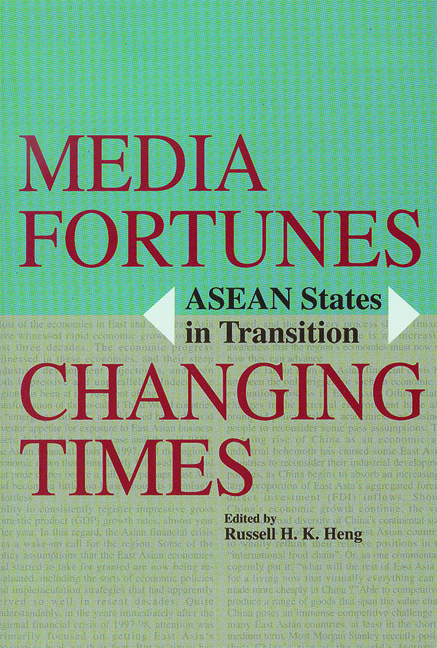Book contents
- Frontmatter
- Contents
- Foreword Wolfgang Möllers
- Acknowledgements
- Contributors
- Introduction
- Chapter 1 Media in Southeast Asia: A Literature Review of Post-1980 Developments
- Chapter 2 Cambodian Media in a Post-Socialist Situation
- Chapter 3 Industrialized Media in Democratizing Indonesia
- Chapter 4 Indonesian Television and the Dynamics of Transition
- Chapter 5 The Impact of Economic Transition on the Media in Laos
- Chapter 6 The Media and Malaysia's Reformasi Movement
- Chapter 7 Myanmar Media: Meeting Market Challenges in the Shadow of the State
- Chapter 8 Singapore: Media at the Mainstream and the Margins
- Chapter 9 Offending Images: Gender and Sexual Minorities, and State Control of the Media in Thailand
- Chapter 10 Vietnamese Media in Transition: The Boon, Curse, and Controversy of Market Economics
- Index
Chapter 10 - Vietnamese Media in Transition: The Boon, Curse, and Controversy of Market Economics
Published online by Cambridge University Press: 03 November 2017
- Frontmatter
- Contents
- Foreword Wolfgang Möllers
- Acknowledgements
- Contributors
- Introduction
- Chapter 1 Media in Southeast Asia: A Literature Review of Post-1980 Developments
- Chapter 2 Cambodian Media in a Post-Socialist Situation
- Chapter 3 Industrialized Media in Democratizing Indonesia
- Chapter 4 Indonesian Television and the Dynamics of Transition
- Chapter 5 The Impact of Economic Transition on the Media in Laos
- Chapter 6 The Media and Malaysia's Reformasi Movement
- Chapter 7 Myanmar Media: Meeting Market Challenges in the Shadow of the State
- Chapter 8 Singapore: Media at the Mainstream and the Margins
- Chapter 9 Offending Images: Gender and Sexual Minorities, and State Control of the Media in Thailand
- Chapter 10 Vietnamese Media in Transition: The Boon, Curse, and Controversy of Market Economics
- Index
Summary
INTRODUCTION
In keeping with the country's socialist political system, Vietnam has a media system which is state-owned and funded. However, beginning in the early 1980s, a wave of market reforms brought about significant changes to the economy in general, and the media in particular. This signalled the beginning of a new policy to stop subsidizing the economy and let market forces take over. Within this new economic orientation, media organizations, like business enterprises, had to learn how to operate without the usual financial handouts. In line with its reduced largesse, the state also eased its control of the economy, thereby allowing media organizations to experiment with new ideas and increase their popularity with consumers. Adjusting to market reforms was, therefore, both a matter of necessity and opportunity. Some of the changes in the media are easily evident, for example the increase in the number of publications. But besides these obvious changes, there remain a few outstanding questions about the Vietnamese media which do not have clear answers yet. An examination of these issues therefore provides an understanding of how far advanced the media is in the transition to a market model.
ADVENT OF MARKET FORCES
In 1986, the VCP (Vietnam Communist Party) formally endorsed doi moi, a reforms programme that began the country's transition from a centrally-planned to a market economy. One fundamental change that came about was the phasing out of state subsidies for most sectors of the state-owned and state-run economy, including the media. Before doi moi, the state provided all media organizations with their operating expenses such as office space, equipment, newsprint, wages and other running costs. In return, the state set the price and the size of the print runs, and regulated the content.
The newspapers before 1986 did not rely on advertisements as a source of revenue. Only one paper in Ho Chi Minh City, Tin Sang (Morning News), which was also the only privately-owned newspaper, had some space for classified advertisements. The print media relied entirely on its circulation for revenue. Whether this covered the cost of production did not matter, because the state always made up for any shortfall.
- Type
- Chapter
- Information
- Media Fortunes, Changing TimesASEAN States in Transition, pp. 231 - 248Publisher: ISEAS–Yusof Ishak InstitutePrint publication year: 2002



